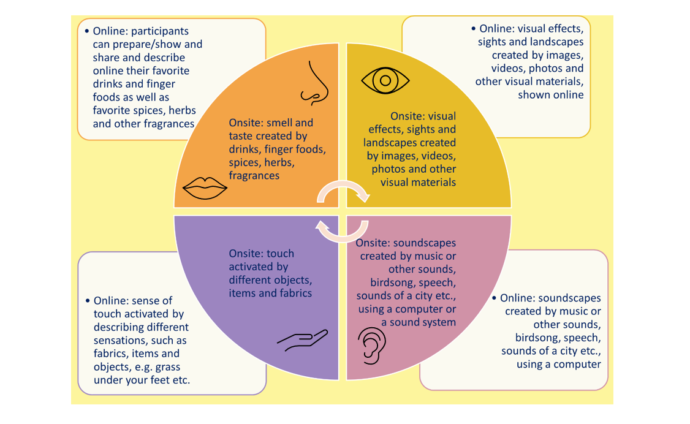From the beautiful Montepellegrino and the rocky cliffs of Scala dei Turchi in Sicily to Bohinjsko Jesero, Lake Bohinj, in Slovenia and to the Finnish autumn forests with mushrooms. These multisensory experiences were part of the now completed Erasmus+ project DISC (Digital Skills for Integration and Active Citizenship). This Laurea-led three-year project (2019-March 2022) was co-funded by the Erasmus+ programme of the European Union. It aimed to enhance the digital skills of people with a migratory background, thus supporting their integration and active participation in local European societies. The project focused on promoting two best practices, Laurea’s Multisensory Space and INCOMA’s SMART PLUS self-assessment tool. In this article, the onsite and online Multisensory Spaces and their possibilities are analysed.
Laurea’s Multisensory Space as an open learning environment

Photo: Artem Podrez/Pexels
Laurea’s Multisensory Space is an internationally rewarded innovation that has been developed since 2007-2008 in several national and international projects. As an open learning environment, it uses all the different senses to create holistic and multisensory learning experiences. Originally, as a method of social work, it was created to support intercultural dialogue and encounters and to bring together people from different cultural backgrounds for sharing multisensory stories, meanings, and memories. Later on, besides being a method of migration and integration work, the Multisensory Space has found its way to support student and client wellbeing, to promote community development and to enhance for example language learning. At best, multisensory methods promote communal learning, and they also allow students and other participants to safely discuss, analyse and compare emotions, values, different cultural practices, and traditions as well as cultural knowledge and wisdom.
A need for online DISC activities
As the DISC project took place during the COVID 19 pandemic, there was a need to create more activities online in addition to creating the more traditional Multisensory Spaces onsite. These onsite spaces could be for example permanent classroom spaces or portable tents that could be used at different locations from libraries and youth houses to community spaces, school premises and daycare units.
In addition to the onsite options, the DISC project partners from Spain, Italy, Belgium, and Slovenia also had a chance to pilot and experience the online versions of the Multisensory Space, using for example Padlet environment, Prezi, Nearpod, Zoom, Canva and different other digital tools. These online spaces utilised different digital possibilities, but they were not completely virtual, as there was no immersive virtual reality technology involved and the Multisensory Space concept was still based on personal encounters and story sharing, though supported by digital means.
Comparing onsite and online Multisensory Spaces
Based on the experiences by the partners and the different pilots done during the DISC project, it can be concluded that multisensory activities can be conducted using varied means. Both the onsite and online Spaces can be created individually or in smaller or bigger groups. When Multisensory Spaces are created onsite, especially in a group, the process is strongly focused on communal and shared learning and experience-based process, whereas online Spaces can be more about individual reminiscence and individual learning, which is then shared with others online. Both ways serve their purpose, so the Multisensory Space facilitators can choose the option that best suits the learning situation.
The process of planning and co-creating the Space is characterized by active listening, respectful negotiation, ability to compromise when working in a group, and sharing of one’s thoughts and feelings. In both cases, whether the Space is onsite or online, it is essential to create a relaxing, supportive and empathic environment where everybody feels safe and comfortable to share their stories and thoughts. Such emotional safety also promotes learning and a sense of belonging, which is especially important when working for example with migrants.
All the senses can be activated in both onsite and online activities, though a bit differently. Visual and audio effects are mostly the same in both onsite and online Multisensory Spaces, whereas the senses of taste, smell, and touch might require extra input and creativity from the Multisensory Space facilitator and the participants to be properly included in the Space creation process. The online activities can include for example individual food preparation with sharing of recipes, baking, tasting together local teas, using herbs and fragrances, or sharing different sensations of for example traditional clothes or sand from the Indian Ocean by the means of visual storytelling. Below, in Picture 1, the onsite and online Multisensory Spaces are compared.
 Picture 1. Comparing onsite and online Multisensory Spaces. Picture: Tiina Wikström.
Picture 1. Comparing onsite and online Multisensory Spaces. Picture: Tiina Wikström.
Finally
In conclusion, it can be said that the Multisensory Space can be translated to online activities as well. In such cases, the co-creation and sharing process takes place online, and it can be as important and rewarding to the participants as the onsite activities. The same essential learning aspects and emotions involved with dialogue and intercultural encounters can be attained online as well.
However, using digital means can limit to certain extent the multisensory aspects of the Space as all the senses are not equally or in the same way engaged. The sense of touch, smell and taste are naturally differently represented in online Multisensory Spaces and might require extra attention and creativity to be properly included in the Space creation process. Also, the onsite Spaces strongly encourage communal learning and negotiation from planning to execution of the Space, whereas online Spaces can be more focused on the individual process. Hence, it is important to choose the option that best suits the learners’ needs.
As the digital and virtual opportunities are constantly advancing, the Multisensory Space might also look quite different in the future. The human need for empathic dialogue, peace promotion and intercultural encounters will though always remain.
For more information about the Multisensory Space, please see the new Multisensory Space Handbook.
Erasmus+ DISC project partners:

Sources:
- Aistien site for the Multisensory Space. Referred 30.3.2022. https://aistienmenetelma.net/en/the-multisensory-space-method/introduction/
- CESIE, Italy. Referred 30.3.2022. https://cesie.org/en/about-us/
- DISC project. Referred 30.3.2022. https://discproject.eu/
- Frangež, D., Bertok, E. & Ručman, A.B. WP2 Multisensory Space Pilot Report Slovenia, 2021.
- INCOMA, Spain. Referred 30.3.2022. https://incoma-projects.eu/
- Laurea’s Multisensory Space achieved recognition in London. The multisensory innovation created at Laurea was awarded by the Global Women Invention & Innovation Network, 15.7.2021. Referred 30.3.2022. https://www.laurea.fi/en/current-topics/news/laureas-multisensory-space-achieved-recognition-in-london/
- Räty, M. & Wikström, T. 2022. The Multisensory Handbook. Referred 30.3.2022. https://urn.fi/URN:ISBN:978-951-799-644-0
- UCLL, Belgium. Referred 30.3.2022. https://www.ucll.be/
- University of Maribor, Slovenia. Referred 30.3.2022. https://www.um.si/en/Pages/default.aspx